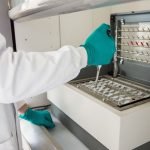New Prediction Model for COVID-19 Hospitalization
Node Smith, ND
Cleveland Clinic researchers have developed and validated a risk prediction model (called a nomogram) that can help physicians predict which patients who have recently tested positive for SARS-CoV-2, the virus that causes COVID-19, are at greatest risk for hospitalization.
New risk prediction model developed to help physicians predict which patients are at greatest risk for hospitalization
This new model, published in PLOS One, is the second COVID-19-related nomogram that the research team — led by Lara Jehi, M.D., chief research information officer at Cleveland Clinic, and Michael Kattan, Ph.D., chair of Lerner Research Institute’s Department of Quantitative Health Sciences — has developed. Their earlier model forecasts an individual patient’s likelihood of testing positive for the virus.
“Ultimately, we want to create a suite of tools that physicians can use to help inform personalized care and resource allocation at many time points throughout a patient’s experience with COVID-19,” said Dr. Jehi, corresponding author on the study.
Newest model developed and validated using retrospective patient data from more than 4,500 patients who tested positive for COVID-19
The team’s newest model was developed and validated using retrospective patient data from more than 4,500 patients who tested positive for COVID-19 at Cleveland Clinic locations in Northeast Ohio and Florida during a three-month time period (early March to early June). Data scientists used statistical algorithms to transform data from registry patients’ electronic medical records into the risk prediction model.
Comparing characteristics between those patients who were and were not hospitalized due to COVID-19 revealed several previously undefined hospitalization risk factors, including:
- Smoking. Former smokers were more likely to be hospitalized than current smokers.
- Taking certain medications. Using univariable analysis, patients taking Angiotensin Converting Enzyme (ACE) inhibitors or angiotensin II type-I receptor blockers (ARBs) were more likely to be hospitalized than patients not taking those drugs.
- Race. African American patients were more likely to be hospitalized than patients of other races.
Dr. Kattan, an expert in developing and validating prediction models for medical decision making, cautions that additional studies will be necessary to further explore the association between ACE inhibitors and ARBs. “In our study, taking these drugs was only found to confer increased risk for hospitalization when run through univariable analysis, which means the observed association could be the result of other, confounding variables, like a preexisting condition.”
Team’s findings also revealed that these patients are more likely to be hospitalized
The team’s findings also revealed that patients presenting with a symptom complex including fever, shortness of breath, vomiting and fatigue were more likely to be hospitalized than those who did not experience this quadrumvirate of symptoms.
The study confirmed other associations previously well-reported in the literature, including higher risk of hospitalization among older people; men; and those with co-morbidities, like diabetes and hypertension, or from lower socioeconomic backgrounds (as measured by zip code).
“Hospitalization can be used as an indicator of disease severity,” said Dr. Jehi. “Understanding which patients are most likely to be admitted to the hospital for COVID-19-related symptoms and complications can help physicians decide not only how to best manage a patient’s care from the time of testing, but also how to allocate beds and other resources, like ventilators.”
The nomogram, which is freely available as an online risk calculator, was shown to be well calibrated and perform well, offering substantially better predictions than using no model at all. The model was also shown to perform well in different geographic regions as data from Ohio and Florida were used in its development.
In addition to further interrogating the association between taking ACE inhibitors and ARBs, it will be important to study on a pathogenic level how these risk factors confer increased hospitalization risk. It is also important to note that the team’s findings only offer associations and do not suggest that these factors are causative.
The study was funded in part by the National Institutes of Health through the Clinical and Translational Science Collaborative of Cleveland.
1. Lara Jehi, Xinge Ji, Alex Milinovich, Serpil Erzurum, Amy Merlino, Steve Gordon, James B. Young, Michael W. Kattan. Development and validation of a model for individualized prediction of hospitalization risk in 4,536 patients with COVID-19. PLOS ONE, 2020; 15 (8): e0237419 DOI: 10.1371/journal.pone.0237419

Node Smith, ND, is a 2017 graduate of NUNM, is licensed in Oregon, and is also working towards licensure in Saskatchewan, Canada, where he lives. Node is associate editor and continuing education director for NDNR. His mission is serving relationships that support the process of transformation, which ultimately leads to healthier people, businesses, and communities. His primary therapeutic tools include counseling, homeopathy, diet and the use of cold water combined with exercise. Node has worked intimately with many groups and organizations within the naturopathic profession, and helped found the non-profit, Association for Naturopathic Revitalization (ANR), which works to promote and facilitate experiential education in Vitalism.










